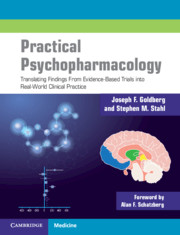 Practical Psychopharmacology
Practical Psychopharmacology from Part I - General Principles
Published online by Cambridge University Press: 19 October 2021
“Necessary clinical adjustments,” as noted in Chapter 1, come with the pharmacological territory for most patients with complex psychiatric disorders – partly because symptoms often can be protean and nonstatic, partly because illness severity can wax and wane, partly because of the impact of cotherapies, and partly from other factors such as pharmacokinetic interactions, treatment nonadherence, loss of efficacy, or other events in the natural evolution of illness. The mechanics and logistics of changing from one pharmacotherapy to another, or deciding when and how to deprescribe an ineffective or otherwise unhelpful medication, are seldom discussed in textbooks or practice guidelines. From an evidence-based perspective, there are few controlled trials designed to compare tolerability and outcomes across various methods and timeframes for stopping and starting or cross-tapering one drug in exchange for another.
To save this book to your Kindle, first ensure [email protected] is added to your Approved Personal Document E-mail List under your Personal Document Settings on the Manage Your Content and Devices page of your Amazon account. Then enter the ‘name’ part of your Kindle email address below. Find out more about saving to your Kindle.
Note you can select to save to either the @free.kindle.com or @kindle.com variations. ‘@free.kindle.com’ emails are free but can only be saved to your device when it is connected to wi-fi. ‘@kindle.com’ emails can be delivered even when you are not connected to wi-fi, but note that service fees apply.
Find out more about the Kindle Personal Document Service.
To save content items to your account, please confirm that you agree to abide by our usage policies. If this is the first time you use this feature, you will be asked to authorise Cambridge Core to connect with your account. Find out more about saving content to Dropbox.
To save content items to your account, please confirm that you agree to abide by our usage policies. If this is the first time you use this feature, you will be asked to authorise Cambridge Core to connect with your account. Find out more about saving content to Google Drive.